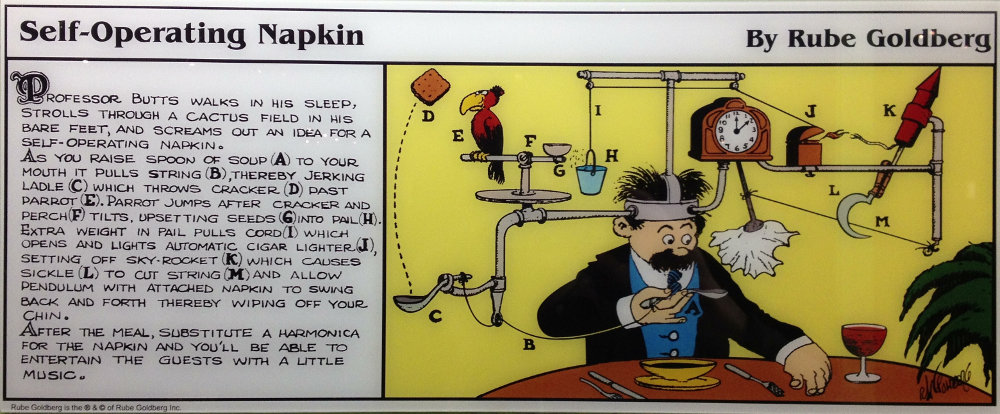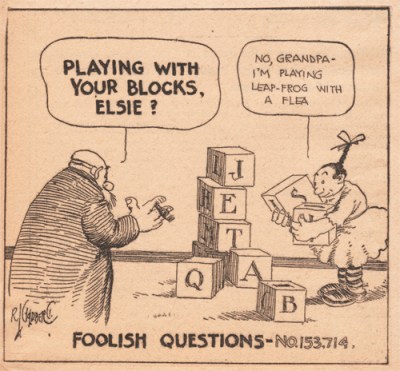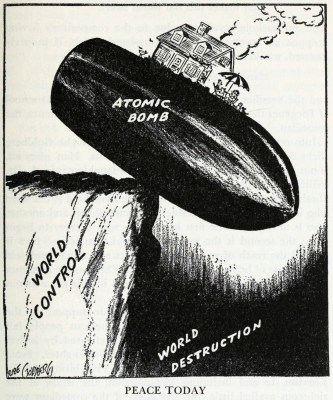Rube Goldberg’s Least Complicated Invention Was His Cartooning Career
Rube Goldberg #RubeGoldberg

The name Rube Goldberg has long been synonymous with any overly-built contraption played for laughs that solves a simple problem through complicated means. But it might surprise you to learn that the man himself was not an engineer or inventor by trade — at least, not for long. Rube’s father was adamant that he become an engineer and so he got himself an engineering degree and a job with the city. Rube lasted six months engineering San Francisco’s sewer systems before quitting to pursue his true passion: cartooning.
Rube’s most famous cartoons — the contraptions that quickly became his legacy — were a tongue-in-cheek critique meant to satirize the tendency of technology to complicate our lives in its quest to simplify them. Interestingly, a few other countries have their own version of Rube Goldberg. In the UK it’s Heath Robinson, and in Denmark it’s Robert Storm Petersen, aka Storm P.
Rube Goldberg was a living legend who loved to poke fun at everything happening in the world around him. He became a household name early in his cartooning career, and was soon famous enough to endorse everything from cough drops to cigarettes. By 1931, Rube’s name was in the Merriam-Webster dictionary, his legacy forever cemented as the inventor of complicated machinery designed to perform simple tasks. As one historian put it, Rube’s influence on culture is hard to overstate.
 Rube’s alma mater Berkeley calls him an engineer’s engineer. Image via Berkeley Engineering Engineer of His Own Future
Rube’s alma mater Berkeley calls him an engineer’s engineer. Image via Berkeley Engineering Engineer of His Own Future
Reuben Garrett Lucius Goldberg was born July 4th, 1883 to Max and Hannah Goldberg in San Francisco, California. He started tracing cartoons in the newspaper at the age of four and kept drawing throughout his childhood. Rube never had any formal drawing lessons, though he did take a few lessons from a sign painter around age 11.
When Rube announced his intent to become a famous cartoonist, his family was horrified. Rube’s father, a policeman and fire commissioner, had worked hard to to provide a good life for his family after emigrating from Germany. He equated artists with beggars, and wanted Rube to be an engineer.
Though Rube still dreamed of becoming a famous cartoonist, he got a mining engineering degree from UC Berkeley in 1904. He then took a job with the city of San Francisco as a water and sewers engineer. Rube hated the job so much that he quit after six months, and took a job at the San Francisco Chronicle for one third the pay. Rube started out at the bottom, emptying wastebaskets, sweeping the floors, and filing photographs. But he still drew every chance he got, and was eventually hired by the San Francisco Bulletin to be their sports cartoonist.
Crazy Contraptions with Explanatory Captions
In 1906, a powerful and deadly earthquake shook San Francisco. Faced with his own mortality, Rube realized that if he wanted to be nationally famous, he’d have to go where the action was — New York City. The following year, Rube moved across the country by train in the hopes of getting hired by a nationally-syndicated newspaper. Just when he was ready to sell his father’s diamond ring for a train ticket back home, he was hired by the New York Evening Mail.
As we all know, Rube Goldberg is most famous for his contraption cartoons that employ ridiculous chain reactions to solve every day problems. These intricate machines were all inventions of Rube’s alter ego Professor Lucifer Gorgonzola Butts, who was loosely based on one of Rube’s engineering professors at Berkeley. He drew the first one of these around 1912 and shot to fame and fortune soon after. Rube spent many hours perfecting his cartoons and would spend upwards of 60 hours drawing a single cartoon.
 Image via The Science Academy
Image via The Science Academy  Image via Screwball Comics
Image via Screwball Comics
Rube drew all kinds of cartoons about sports, politics, and current events. Soon after getting hired at the New York Evening Mail, Rube started his first nationally-syndicated cartoon called “Foolish Questions”. These single-panel cartoons depicted one person asking another a question where the answer is painfully obvious. But as the saying goes, ask a foolish question, and you’ll get a foolish answer — the retort is usually an oddly-specific oddball answer.
Between 1905 and 1938, Rube drew more than 60 different cartoon series including “Foolish Questions”, “The Inventions of Professor Lucifer Gorgonzola Butts”, and “Mike and Ike (They Look Alike)”, which likely spawned the candy of the same name.
Rube drew so many different strips and panels throughout his career that historians have a hard time cataloguing it all. In 1930, Rube’s inventions came to life on the silver screen in the movie Soup to Nuts, which introduced the world to the slapstick comedy of the Three Stooges.
 Image via Wikimedia Commons Still Relevant, Still a Household Name
Image via Wikimedia Commons Still Relevant, Still a Household Name
Rube Goldberg had an amazing 72-year career as a cartoonist. Throughout his career, he drew an estimated 50,000 cartoons, both political and otherwise.
Rube won the 1948 Pulitzer Prize for Editorial Cartooning for a single-frame political cartoon called “Peace Today” that depicts a nuclear family balanced on a precipice dividing world domination from total destruction of same. He never stopped making art and became a sculptor at age 80. He died in 1970 at the age of 87.
Although Rube may never have built any of his own creations, his imagination continues to inspire people to invent their own wild ways of solving problems and make them come to life. All across America, schools hold contraption-building competitions every year in his honor, often with a required minimum number of actions.
We’ve seen plenty of Rube Goldberg-inspired builds over the years. Here’s one that systematically opens a bottle of beer, and another that uses a CNC router to scrape the stuf out of Oreos. Have you ever built a Rube Goldberg machine? Let us know in the comments!